
The Holy Lavra of Saint Sabbas, known in Arabic and Syriac as Mar Saba and historically as the Great Laura of Saint Sabas, is a Greek Orthodox monastery overlooking the Kidron Valley in the Bethlehem Governorate of Palestine, in the West Bank, at a point halfway between Bethlehem and the Dead Sea. The monks of Mar Saba and those of subsidiary houses are known as Sabaites.

Ein Karem is a historic mountain village southwest of Jerusalem, presently a neighborhood in the outskirts of the modern city, within the Jerusalem District. It is the site of the Hadassah Medical Center.

Suba was a Palestinian Arab village west of Jerusalem that was depopulated and destroyed in 1948. The site of the village lies on the summit of a conical hill called Tel Tzova, or Jabal Suba, rising 769 meters above sea level, and it was built on the ruins of a Crusader castle.

Taybeh is a Christian Palestinian village in the West Bank, 15 kilometers northeast of Jerusalem and 12 kilometers northeast of Ramallah, in the Ramallah and al-Bireh Governorate of Palestine. It is 850 meters above sea level. According to the Palestinian Central Bureau of Statistics, Taybeh had a population of 1,340 in 2017.

Aboud is a Palestinian village in the Ramallah and al-Bireh Governorate of the State of Palestine, in the central West Bank, northwest of Ramallah and 30 kilometers north of Jerusalem. Nearby towns include al-Lubban to the northeast and Bani Zeid to the northwest.

The Church of Saint George in the city of Lod is a Greek Orthodox church containing a sarcophagus venerated as the tomb of the fourth-century Christian martyr Saint George.

Theodosius the Cenobiarch was a monk, abbot, and saint who was a founder and organizer of the cenobitic way of monastic life in the Judaean desert. His feast day is on January 11.

Al-Khader is a Palestinian town in the Bethlehem Governorate of the State of Palestine, in the south-central West Bank. It is located 5 kilometers (3.1 mi) west of Bethlehem. According to the Palestinian Central Bureau of Statistics, the town had a population of 11,960 in 2017. The area around al-Khader is marked by vineyards, and olive and fig trees.
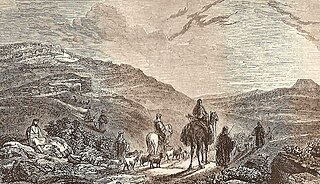
Teqoa is a Palestinian town in the Bethlehem Governorate, located 12 km (7.5 mi) southeast of Bethlehem in the West Bank. The town is built adjacent to the biblical site of Tekoa (Thecoe), now Khirbet Tuqu', from which it takes its name. Today's town includes three other localities: Khirbet ad-Deir, al-Halkoom, and Khirbet Teqoa. According to the Palestinian Central Bureau of Statistics (PCBS), Teqoa had a population of 8,767 in 2017.
Cyril of Scythopolis, also known as Cyrillus Scythopolitanus, was a Christian monk, priest and Greek-language hagiographer or historian of monastic life in Palestine in the early years of Christianity.
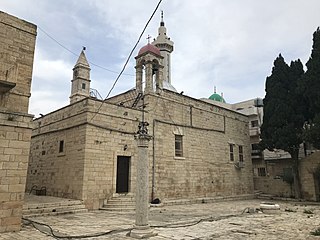
The Monastery and Church of Saint George in Al-Khader is an Eastern Orthodox Christian religious site in the Palestinian town of al-Khader, near Beit Jala and Bethlehem, in the central West Bank of the State of Palestine. The town of Al-Khader is named after Saint George, who in Arab culture is known as "al-Khadr"; the church is considered to be the most important sanctuary to al-Khadr in Palestine.

Al-Ubeidiya is a Palestinian town located 6 kilometers (3.7 mi) east of Bethlehem. The town is a part of the Bethlehem Governorate in the central West Bank. According to the Palestinian Central Bureau of Statistics (PCBS), al-Ubeidiya had a population of over 14,460 in 2017.
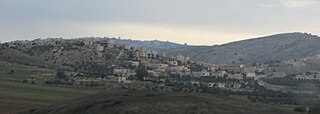
Deir al-'Asal al-Fauqa is a Palestinian town located sixteen kilometers west of Hebron.The town is in the Hebron Governorate Southern West Bank. According to the Palestinian Central Bureau of Statistics, the town had a population of 1,859 in 2017.

The Monastery of Saint George of Choziba, also known as Monastery ofChoziba or Mar Jaris, is a monastery located in Wadi Qelt in Area C of the eastern West Bank, in the Jericho Governorate of the State of Palestine. The cliff-hanging complex, which emerged from a lavra established in the 420s and reorganised as a monastery around AD 500, with its ancient chapel and irrigated gardens, is active and inhabited by Greek Orthodox monks. It houses the relics of Saint George of Choziba, after whom the monastery is named, as well as the relics of Saint John of Choziba (420/450–520/530) and those of Saint John of Choziba the Romanian (1913–1960).
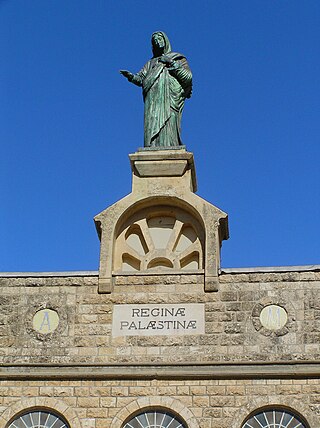
Deir Rafat, also known as the Shrine of Our Lady Queen of Palestine and of the Holy Land, is a Catholic monastery in central Israel. Located to the north-west of Beit Shemesh, between Givat Shemesh and kibbutz Tzora to the south and Kfar Uria to the north, it falls under the jurisdiction of Mateh Yehuda Regional Council. In 2022 it had a population of 97.

The Monastery of the Temptation is a Greek Orthodox monastery located in Jericho, Palestine. It was built on the slopes of the Mount of Temptation 350 meters above sea level, situated along a cliff overlooking the city of Jericho and the Jordan Valley. Its most ancient structures date back to the 6th century, having been built above the cave traditionally said to be that where Jesus spent forty days and forty nights fasting and meditating while he was tempted by Satan.

Mar Elias Monastery is a Greek Orthodox monastery in south Jerusalem, on a hill overlooking Bethlehem and Herodium, near Hebron Road.

Khirbet Beit Zakariyyah is a small Palestinian village southwest of Bethlehem in the West Bank, perched on a hill that rises about 995 metres (3,264 ft) above sea level. Administratively, it is associated with the village of Artas under the Bethlehem Governorate. It is also located in between the Israeli settlements of Alon Shevut and Rosh Tzurim, both of which were built on land confiscated from the village. The village had a population of 142 in 2017.
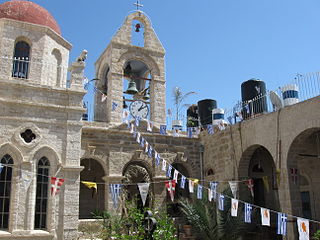
Deir Hajla or Deir Hijleh is the Arabic name of the Greek Orthodox Monastery of Saint Gerasimus, a monastery located in the Jericho Governorate of the State of Palestine, in the West Bank, west of the River Jordan and north of the Dead Sea.
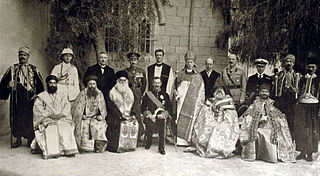
The Holy and Ancient Archdiocese of Jerusalem, All Palestine, and All the Near East or the Coptic Orthodox Patriarchate in Jerusalem, is a Metropolitan Archdiocese of the Coptic Orthodox Church, which is part of the wider communion of the Oriental Orthodox Church. It is headed by the Coptic Orthodox Metropolitan Archbishop of Jerusalem, the incumbent being Metropolitan Archbishop Antonious of Jerusalem since 2016. Its jurisdiction covers those Coptic Orthodox Christians living in the Near East; with churches and monasteries in the State of Israel, State of Palestine, the State of Kuwait, the Hashemite Kingdom of Jordan, the Lebanese Republic, the Syrian Arab Republic, and the Republic of Iraq. The adherents are largely of Coptic Egyptian descent, mainland Coptic migrants and their descendants. The archdiocese is based at St Anthony's Monastery, in the Christian Quarter of the Old City of Jerusalem, beside the Church of the Holy Sepulchre.






















